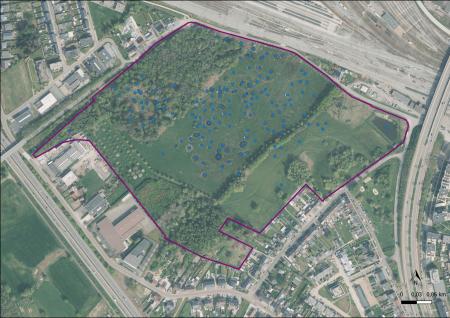
Area characterisation:
The pondscape is owned by the municipality Hasselt and was leased as pasture to farmers until 1995. From 1996 onwards, it was managed by a nature conservation NGO (now ‘Natuurpunt’). Tommelen has officially been designated as nature reserve in 2006 because of its high ecological and historical value. The management is financed by subsidies from the Flemish government (after agreement on management proposal). Budget for habitat restoration and creation comes from additional projects. Natuurpunt provides additional funding from their own overall budget if needed. The day-to-day management is done by a local team of volunteers. Current management involves maintenance of existing ponds by periodic dredging, cutting back trees, and mowing of bank vegetation. Biodiversity is regularly monitored.
Objective:
The bombcrater pondscape is located very close to the city of Hasselt and has been created unintentionally in 1944 during World War II. It was designated as a nature reserve in 2006 and became a place for the preservation of biodiversity and for people to enjoy nature closeby to the city .
Financing:
PONDERFUL has received funding from the European Union's Horizon 2020 research and innovation programme under grant agreement No 869296
Potential impacts/benefits:
- - Biodiversity enhancement
- - Human health
Actions:
- Protection status as nature reserve.
- Pond restoration.
- Maintenance of forest clearings.
- Removal of alien plant species (specifically, Crassula helmsii).
- Filling of two ponds with large population of Crassula helmsii.
- Mowing of pond edges.
- Dredging of terrestrialised ponds (in 2009-2010, in 2021-2022).
- Restrict access of cattle to a subset of ponds by fencing .
- Maintenance and creation of overwintering habitat for amphibians (such as Rana esculenta synklepton, Rana temporaria, Bufo bufo, Triturus alpestris, Triturus cristatus,Triturus vulgaris and Hyla arborea).
- The creation of additional new ponds (n=3) is planned in 2024.
- Maintenance of walking paths.
- Creation of observation tower.
- Installation of picnic spots.
- Creation and maintenance of information sheets.
- Installation of sluice on drainage ditch to slow drainage and keep more water in the pondscape
Transferability of result:
In 2021, the pondscape has been recolonized by Hyla arborea. It had gone locally extinct since 1980 and the lack of connectivity (urban setting and surrounded by heavily used car roads and a railway) likely hampered re-colonization. The sudden recolonization might be due to the increase in occurrences and overall population density of Tree frog in the region, and the rather wet spring in 2022, which might have facilitated dispersal. The aim for the future is to expend ongoing management interventions and to promote connectivity to maintain amphibian species diversity.
Lessons learnt:
The designation of the pondscape as ‘nature reserve‘ was very important as it allowed the creation of a management plan and facilitated access to essential financial funding.
Currently it is a unique nature reserve since it shelters high biodiversity (among which large populations of seven species of amphibians) in a highly urbanised setting.
Contacts:
pieter.lemmens@kuleuven.be
louisa.plueskow@igb-berlin.de
Global goals:
-
3. Good Health and well being
-
13. Climate action
-
14. Life below water
NBS goals:
- Restoring ecosystems and their functions
- Developing climate change mitigation
- Developing climate change adaptation
- Multi-functional nature-based watershed management and ecosystem restoration
NBS benefits:
- Increase Biodiversity
- Increase well-being